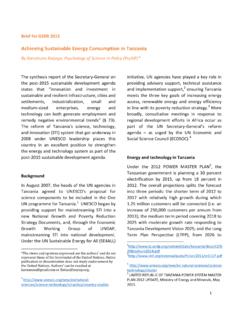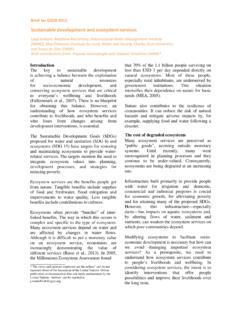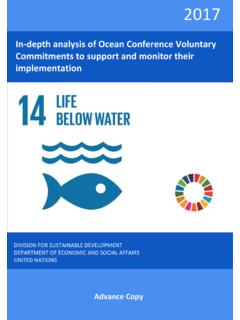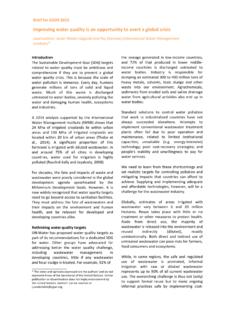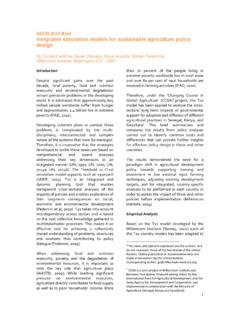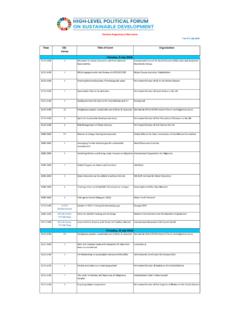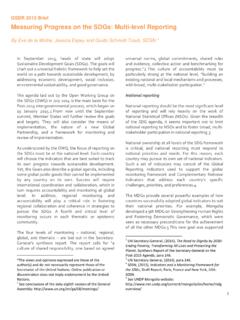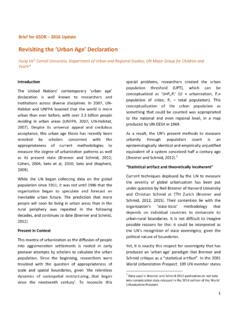Transcription of Blue Economy Concept Paper 1). Introduction
1 1 blue Economy Concept Paper 1). Introduction The Rio +20 United Nations Conference on Sustainable Development (UNCSD), held in Rio de Janeiro, 20-22 June 2012, focused on two key themes the further development and refinement of the Institutional Framework for Sustainable Development and the advancement of the Green Economy Concept . The meeting, in its outcome document, reaffirmed poverty eradication as its key challenge: Eradicating poverty is the greatest global challenge facing the world today and an indispensable requirement for sustainable development. In this regard we are committed to freeing humanity from poverty and hunger as a matter of urgency. (Para 2. The future we want. UNCSD 2012). The Green Economy Concept is structured to reflect this, being explicitly based and presented in the context of sustainable development and poverty eradication: We consider green Economy in the context of sustainable development and poverty eradication as one of the important tools available for achieving sustainable We emphasize that it should contribute to eradicating poverty as well as sustained economic growth, enhancing social inclusion, improving human welfare and creating opportunities for employment and decent work for all, while maintaining the healthy functioning of the Earth s ecosystems.
2 (Para 56. The future we want. UNCSD 2012). Throughout the preparatory process for Rio +20, many coastal countries questioned the focus of the Green Economy and its applicability to them. Strong positions were presented to the Rio +20 preparatory process for a blue Economy approach to be more prominently addressed. This approach has broad relevance as the Oceans, including humankind s common heritage of the High Seas, represent in many respects the final frontier for humanity and its quest for sustainable development. Institutional efforts were made to expand the blue aspect of the Green Economy as embodied in the Green Economy in a blue World report1 but international momentum has moved beyond this. Throughout and subsequent to the Rio +20 process there has been a growing appreciation that the world s Oceans and Seas require more in depth attention and coordinated action. This has been reflected in various initiatives inter alia the UNDESA expert group meeting on Oceans, Seas and Sustainable Development, the work of the Global Ocean Commission, the Global Partnership for Oceans and the prominence given to oceans and seas in the UN five-year Action Agenda 2012-2016.
3 Coastal and Island developing countries have remained at the forefront of this blue Economy advocacy, recognising that the oceans have a major role to play in humanity s future and that the blue Economy offers an approach to sustainable development better suited to their circumstances, constraints and challenges. 1 UNEP, FAO, IMO, UNDP, IUCN, GRID-Arendal (2012). 2 Cutting edge technologies and rising commodity prices are opening up new realms of opportunity for submarine exploitation, the High Seas constitute the last global commons and urgent attention is required to enable the sound management of ocean resources for the realisation of sustainable development. 2). blue Planet Oceans cover 72% of the surface of our blue planet and constitute more than 95% of the biosphere.
4 Life originated in the oceans and they continue to support all life today by generating oxygen, absorbing carbon dioxide, recycling nutrients and regulating global climate and temperature. Oceans provide a substantial portion of the global population with food and livelihoods and are the means of transport for 80% of global trade2. The marine and coastal environment also constitutes a key resource for the important global tourism industry; supporting all aspects of the tourism development cycle from infrastructure and the familiar sun, sand and sea formula to the diverse and expanding domain of nature-based tourism. The seabed currently provides 32% of the global supply of hydrocarbons with exploration expanding. Advancing technologies are opening new frontiers of marine resource development from bio-prospecting to the mining of seabed mineral resources. The sea also offers vast potential for renewable blue energy production from wind, wave, tidal, thermal and biomass sources.
5 Human development activities, however, have seriously taxed the resilience of the marine and coastal resource base. FAO data indicates that 87% of global fish stocks are fully or over exploited3. Increasing pollution and unsustainable coastal development further contribute to the loss of biodiversity, ecological function and the decline in provision of environmental services. Climate change threatens to remove literally the very foundations of broad swathes of coastal development whilst rising atmospheric CO2 levels are undermining fundamental aspects of many marine ecosystems through ocean acidification; changing ocean chemistry at a speed faster than at any time in the last 300 million years4. The potential of the oceans to meet sustainable development needs is enormous; but only if they can be maintained in and/or restored to a healthy, and productive state. The importance of oceans for sustainable development has been recognised from the beginning of the UNCED process, in Agenda 21, the Johannesburg Plan of Implementation and reaffirmed in the outcome document of the Rio+20 Conference; but ongoing trends of exploitation and degradation of marine and coastal ecosystems show that endeavours to date have been insufficient and that more needs to be and must be done.
6 2 UNCTAD (2012). 3 FAO (2012). 4 IGBP, IOC, SCOR (2013). 3 3). The blue Economy a Framework for Sustainable Development The blue Economy is a developing world initiative pioneered by SIDS but relevant to all coastal states and countries with an interest in waters beyond national jurisdiction. SIDS have always been highly dependent upon the seas for their well-being but the blue Economy , whilst encompassing the Concept of ocean-based economies, goes far beyond that. The blue Economy conceptualises oceans as Development Spaces where spatial planning integrates conservation, sustainable use, oil and mineral wealth extraction, bio-prospecting, sustainable energy production and marine transport. The blue Economy breaks the mould of the business as usual brown development model where the oceans have been perceived as a means of free resource extraction and waste dumping; with costs externalised from economic calculations.
7 The blue Economy will incorporate ocean values and services into economic modelling and decision-making processes. The blue Economy paradigm constitutes a sustainable development framework for developing countries addressing equity in access to, development of and the sharing of benefits from marine resources; offering scope for re-investment in human development and the alleviation of crippling national debt burdens. The blue Economy espouses the same desired outcome as the Rio +20 Green Economy initiative namely: improved human well-being and social equity, while significantly reducing environmental risks and ecological scarcities (UNEP 2013) and it endorses the same principles of low carbon, resource efficiency and social inclusion, but it is grounded in a developing world context and fashioned to reflect the circumstances and needs of countries whose future resource base is marine. Fundamental to this approach is the principle of equity ensuring that developing countries: Optimise the benefits received from the development of their marine environments fishery agreements, bioprospecting, oil and mineral extraction.
8 Promote national equity, including gender equality, and in particular the generation of inclusive growth and decent jobs for all. Have their concerns and interests properly reflected in the development of seas beyond national jurisdiction; including the refinement of international governance mechanisms and their concerns as States proximate to seabed development. The mainstreaming of equity at international and national levels offers scope for developing countries to realise greater revenue from their resources and reinvest in their populace, environmental management, reduce national debt levels and contribute to the eradication of poverty and hunger. At the core of the blue Economy Concept is the de-coupling of socioeconomic development from environmental degradation. To achieve this, the blue Economy approach is founded upon the assessment and incorporation of the real value of the natural ( blue ) capital into all aspects of economic activity (conceptualisation, planning, infrastructure development, trade, travel, renewable resource exploitation, energy production/consumption).
9 Efficiency and optimisation of resource use are paramount whilst respecting environmental and ecological parameters. This includes where sustainable the sourcing and usage of local raw materials and utilising where feasible blue low energy options to realise efficiencies and 4 benefits as opposed to the business as usual brown scenario of high energy, low employment, and industrialised development models. The blue Economy approach recognises and places renewed emphasis on the critical need for the international community to address effectively the sound management of resources in and beneath international waters by the further development and refinement of international law and ocean governance mechanisms. Every country must take its share of the responsibility to protect the high seas, which cover 64 % of the surface of our oceans and constitute more than 90% of their volume. 4). SIDS and the blue Economy The importance of marine and coastal resources to SIDS is evident, and has been elaborated in numerous international fora.
10 The blue Economy , however, offers the potential for SIDS to alleviate one of their defining obstacles to sustainable development; namely that of a narrow resource base. The remarkable per capita marine resource area enjoyed by many SIDS means that the blue Economy approach offers the prospect of sustained, environmentally-sound, socially inclusive economic growth. SIDS must prepare now in order to position themselves properly to realise the optimal benefits for their sustainable development from the coming blue revolution. The benefits of the blue Economy , however, are not exclusively tailored for SIDS, they are equally applicable to coastal countries and ultimately the blue Economy approach offers the means for the sound utilisation of resources beyond national jurisdiction the sustainable development of the common heritage of humanity; the resources of the High Seas. 5). The blue Economy Issues The natural world made up of the physical environment, its mineral components and biodiversity at all three levels (genetic, species, ecosystem) is intrinsically interconnected and the more diverse and productive the natural system, the greater the degree of interconnectivity.

